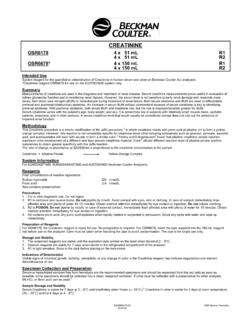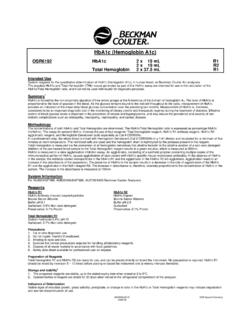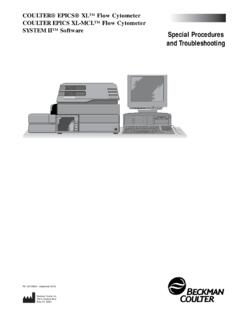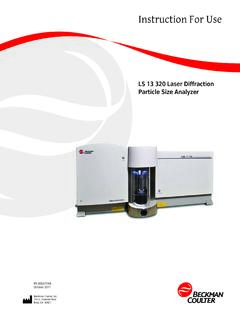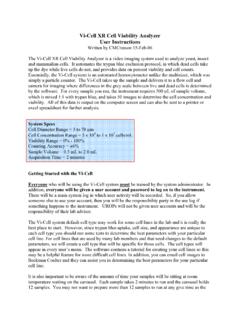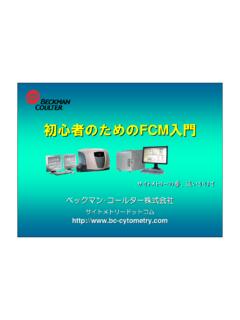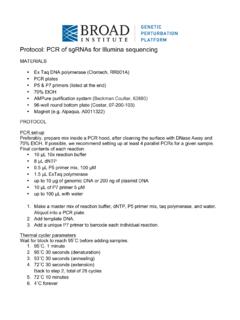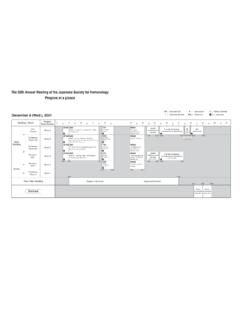Transcription of HDL-CHOLESTEROL - Beckman Coulter
1 OSR General Chemistry 2009-08 HDL-CHOLESTEROL OSR6195 4 x 30 mL R1 4 x 10 mL R2 OSR6295 4 x 50 mL R1 4 x mL R2 Intended Use System reagent for the quantitative determination of HDL-CHOLESTEROL concentrations in human serum and plasma on Beckman Coulter AU analyzers. Summary Many epidemiological investigations have demonstrated the strong and independent inverse association between HDL-CHOLESTEROL and the risk of coronary artery , 2 It has been proposed that HDL particles, through the uptake and transport of cholesterol from peripheral tissue to the liver (reverse cholesterol transport), protects against the development of atheromatous Under the guidelines issued by The National cholesterol Education Program Adult Treatment Panel 2 (NCEP ATP 2),4 it is recommended that both HDL-CHOLESTEROL and Total cholesterol should be measured in the initial screening for hypercholesterolemia.
2 In 2001, the NCEP increased the high-risk medical decision point to <40 The guidelines classify HDL- C levels as follows: 1. < 40 mg/dL as indicative of a major risk factor for Coronary Heart Disease. 2. > 60 mg/dL as a negative risk factor for Coronary Heart Disease. Methodology The HDL-CHOLESTEROL test is a two reagent homogenous system for the selective measurement of serum or plasma HDL-CHOLESTEROL in the presence of other lipoprotein particles. The assay is comprised of two distinct phases. In phase one, free cholesterol in non-HDL-lipoproteins is solubilized and consumed by cholesterol oxidase, peroxidase, and DSBmT to generate a colorless end product. In phase two a unique detergent selectively solubilizes HDL- lipoproteins. The HDL cholesterol is released for reaction with cholesterol esterase, cholesterol oxidase and a chromogen system to yield a blue color complex which can be measured bichromatically at 600/700nm.
3 The resulting increase in absorbance is directly proportional to the HDL-C concentration in the sample. Reaction Phase 1 Accelerator + CO LDL, VLDL Chylomicrons Colorless end product DSBmT + Peroxidase Reaction Phase 2 HDL Specific detergent HDL cholesterol HDL Disrupted CHE and CHO HDL cholesterol + H2O + O2 Cholest-4-en-3-one + H2O2 Peroxidase H2O2 + DSBmT + 4-AAP Blue color complex This reagent was tested in a cholesterol Reference Method Laboratory Network (CRMLN)
4 Laboratory to confirm that it meets the guidelines of the NCEP. System Information For AU400/400e/480, AU600/640/640e/680 and AU2700/5400 Beckman Coulter Analyzers. Reagents Final concentration of reactive ingredients: Goods Buffer (pH ) cholesterol esterase (Pseudomonas) 375 U/L cholesterol oxidase ( ) 750 U/L Peroxidase (Horseradish) 975 U/L Ascorbate oxidase (Curcubita sp,) 2250 U/L DSBmT mmol/L 4-aminoantipyrine mmol/L Detergent % Preservative % Precautions 1.
5 For in vitro diagnostic use. 2. Do not ingest. Harmful if swallowed. Preparation of Reagents The HDL-CHOLESTEROL reagent is ready for use. No preparation is required. Storage and Stability 1. The unopened reagents are stable until the expiration date printed on the label when stored at 2 8 C. 2. Opened reagents are stable for 30 days when stored in the refrigerated compartment of the analyzer. 3. Do not use reagents that have been frozen. 4. Protect the reagents from direct sunlight. HDL-CHOLESTEROL OSR General Chemistry 2009-08 Indications of Deterioration Visible signs of microbial growth, turbidity, or precipitate in the HDL-CHOLESTEROL reagent may indicate degradation and warrant discontinuance of use. Specimen Collection and Preparation Serum and EDTA or heparinized plasma samples drawn from the patient after a 12 14 hour fast are the recommended specimens.
6 Separate serum from red blood cells as soon as possible (within 3 hours). Plasma using anticoagulants such as citrate or oxalate are not Sample Storage and Stability Use fresh sample for analysis when possible. Serum or plasma should not remain at 15 30 C longer than 14 hours. If analysis is not completed within 14 hours serum or plasma may be stored at 2 8 C for up to 1 week. If specimens need to be stored for more than 1 week they may be preserved at less than - 70 C for up to 3 months. Samples should only be frozen Interfering Substances Results of studies conducted7 show that the following substances interfere with this HDL-CHOLESTEROL procedure. The criteria for no significant interference is recovery within 10% of the initial value. Ascorbate: No significant interference up to 20 mg/dL Ascorbate Bilirubin: No significant interference up to 40 mg/dL conjugated Bilirubin No significant interference up to 40 mg/dL unconjugated Bilirubin Globulin No significant interference up to 5 g/dL added Gamma-Globulin Hemolysis: No significant interference up to 500 mg/dL Hemolysate Lipemia: No significant interference up to 1500 mg/dL Intralipid* Triglyceride: No significant interference up to 900 mg/dL Triglyceride** *Intralipid, manufactured by KabiVitrium Inc.
7 , is a 20% IV fat emulsion used to emulate extremely turbid samples. **Triglyceride concentrate, manufactured by Miles Pentex, cat. no. 96-051-6, was used to measure triglyceride interference. No significant interference was observed from samples containing native triglycerides up to 1000mg/dL. However, there is poor correlation between lipemia and triglyceride concentration. The information presented is based on results from Beckman Coulter studies and is current at the date of publication. Beckman Coulter Inc. makes no representation about the completeness or accuracy of results generated by future studies. For further information on interfering substances, refer to Young8 for a compilation of reported interferences with this test. In very rare cases gammopathy, especially monoclonal IgM (Waldestr m s macroglobulinemia), may cause unreliable results. Procedure A complete list of test parameters and operational procedure can be found in the User s Guide appropriate to the analyzer.
8 Materials Provided HDL-CHOLESTEROL Reagent Materials Required But Not Provided HDL-CHOLESTEROL Calibrator (Cat # ODC0023) Stability of Final Reaction Mixture The Beckman Coulter AU analyzer automatically computes every determination at the same time interval. Calibration The frequency of calibration is every 7 days. Calibration of this HDL-CHOLESTEROL procedure is accomplished by the use of the HDL-CHOLESTEROL Calibrator material (Cat. No. ODC0023). Recalibration of this test is required when any of these conditions exist: 1. A reagent lot number has changed or there is an observed shift in control values. 2. Major preventative maintenance was performed on the analyzer. 3. A critical part was replaced. Quality Control During operation of the Beckman Coulter AU analyzer, at least two levels of lipid control material should be tested a minimum of once a day. In addition, controls should be performed after calibration, blanking, with each new lot of reagent, and after specific maintenance or troubleshooting steps described in the appropriate User s Guide.
9 Quality control testing should be performed in accordance with regulatory requirements and each laboratory s standard procedure. Results No manual calculations are required. Results are printed out automatically for each sample in mg/dL at 37 C. For Units (mmol/L) the results must be divided by Dynamic Range The HDL-CHOLESTEROL procedure is linear from mg/dL to mg/dL. Samples should be diluted with physiological saline, the assay repeated and the result multiplied by the dilution factor whenever values exceed the upper limit of linearity. Endogenous triglyceride levels gave acceptable performance up to 2000 mg/dL. Samples with triglyceride levels > 2000 mg/dL should be diluted. Samples may be diluted, repeated, and multiplied by the dilution factor automatically utilizing AUTO REPEAT RUN. Expected Values Adults:9 23 92 mg/dL Expected values may vary with age, sex, diet, and geographical location.
10 Each laboratory should determine its own expected values as dictated by good laboratory practice. Specific Performance Characteristics The following data was obtained using the HDL-CHOLESTEROL Reagent on Beckman Coulter AU analyzers according to established procedures. Results obtained in individual laboratories may differ. HDL-CHOLESTEROL OSR General Chemistry 2009-08 Precision11 Estimates of precision, based on CLSI recommendations10, are consistent with typical performance.
